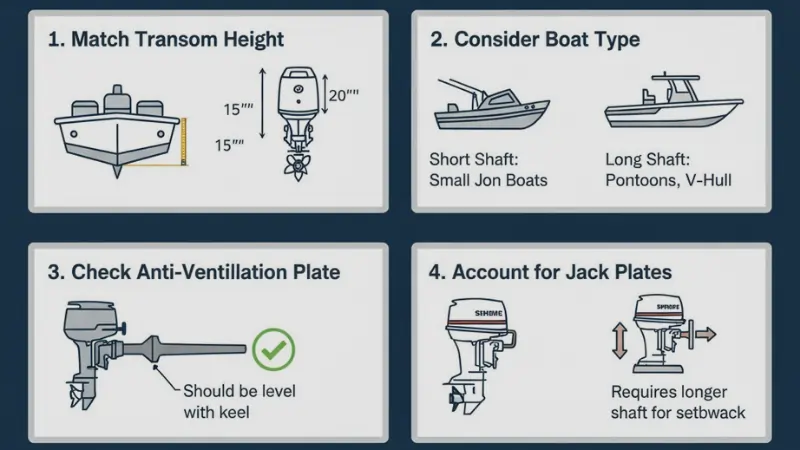How To Measure A Boat Motor Shaft
I remember the first time I hooked up a new outboard to my old fishing boat. The thing wouldn’t plane right, and I spent half the day tinkering, thinking it was the prop or fuel mix. Turns out, the shaft length was all wrong—just a few inches off, and it messed everything up. That’s when I learned how to measure a boat motor shaft properly; you can’t skip it. It’s the difference between a smooth cruise and constant frustration on the water.
Most folks grab a motor without double-checking this, but sizes run standard: short at 15 inches for flat-bottom skiffs, long at 20 for deeper V-hulls, and extra-long at 25 for bigger setups. Match it to your boat’s transom, and suddenly the prop bites clean without sucking air or scraping bottom. Once you nail this, boating feels easier, like the motor’s part of the boat instead of fighting it. It’s the same attention to detail you get with a professional NYC yacht rental, they handle these specs so you can just enjoy the water. Let’s walk through how to get it spot on.
Understanding Boat Motor Shaft Length

.That shaft is basically the leg dropping your propeller down from the clamp. It needs to position the prop just right in the water for good push. Get the length off, and you either cavitate—where air bubbles make the engine race without moving—or the lower unit drags and wears out fast. Makers stick to those three main sizes so you can swap without custom work.
Last weekend, I helped a buddy with his bass boat. His short shaft on a taller transom had him poring over forums late at night. We swapped to a long one, and boom, it jumped on the throttle like new. So, before you buy, eye your boat’s back end. It all starts with knowing what fits your hull type.
Preparing to Take Measurements
Park the boat where it won’t wobble—trailer on flat ground or tied off in still water. Shim the axle with wood if the tongue dips funny, because even a slight lean skews the tape. Sweep away any junk from the stern; tangled lines or coolers block your view quick.
Pick up a cloth tape measure, the kind tailors use, since it hugs curves without snapping back. Rope in a pal to steady one end if the boat’s wide. Scribble the model and year on a scrap first. Those details line up with charts later, saving you from wild guesses.
Step-by-Step Guide to Measuring Shaft Length

Step 1: Locate the Transom
Walk to the stern and face the rear. Your transom’s that upright panel at the very back, built strong for motor weight. It meets the hull bottom clean, no frills. Pinpoint it now, or your whole job’s off kilter.
Trace the top with your fingers till you hit the clamp brackets. Skip any add-on rails; they’re not the true start. On wood transoms, watch for rot spots that dip the edge. Solid base here means reliable numbers ahead.
Step 2: Find the Anti-Cavitation Plate
Tilt the motor down flat. Up top of the gear case, you’ll see the anti-cav plate—a broad, flat shield keeping water steady around the prop. No air pockets means no spin-outs mid-turn. Catch it gleaming if the sun hits right.
Brush off slime or salt buildup first. It hides the edge easy after a season. Clamp the motor firm so it doesn’t swing. Both marks locked in? Good, the hard part’s behind you.
Step 3: Measure from Transom to Plate
Hook the tape’s zero at the transom’s upper clamp line. Let it fall straight along the motor’s center groove to the plate’s bottom lip. Pull snug but not stretched—read where it lands. There’s your magic number for the shop order.
Repeat from a different angle if doubt creeps in. Gusts nudge boats around, so brace against the wind. Note it in sixteenths if you’re picky, but whole inches work fine. Wrap this up, and you’re armed for the right pick.
Measuring Transom Height
From keel up to transom top, that’s your height—key for spotting if the boat runs standard or tall. Hang a weighted string from the edge down to hull base for a dead-straight drop. It hangs true no matter the sway. Cross-check this against shaft to catch mismatches early.
Plenty of flats boats top out at 15 inches, while offshore hulls push 20 or more. Yours might surprise you after mods. Line the figures next to each other on paper. Any gap screams for a riser kit.
Jack the trailer even with shims under tires. Go slow, measure again from keel mark. Tuck both stats in your phone notes. Now the puzzle pieces snap together.
Common Mistakes to Avoid
Newbies tape from an aftermarket bracket, bloating the count by two inches easy. Drop back to the stock hull line always. One fix like that, and you’re golden. No more second-guessing at the ramp.
Rough water or uneven ramps tilt the stern, bending your tape into lies. Wedge blocks firm underneath first. Steady setup pays off big. Skip the drama, keep it level.
Leave the motor tilted, and the plate rides high out of reach. Slam it down full each go. Little habits like this build trust in your reads. End with facts you can bank on.
Tips for Choosing the Right Shaft Length

Aim the plate to hover an inch below the hull in gear. Prop stays gripped without sucking weeds or rocks. Flip through the boat’s spec sheet for dead-on advice. It whittles choices down sharp.
Factor in your haunts—glass-calm rivers love short shafts, but swells demand extra reach. Corner a marine tech on local quirks. They steer you past common snags.
Bolt on a jack plate for near-misses; it adjusts height without a tear-down. Mock up with cardboard if testing live. Settle on what hums right for your runs. Solid choice means miles of trouble-free miles.
Conclusion On how to measure a boat motor shaft
Sizing that shaft comes down to transom start, plate end, and a true line between. Miss it, and outings turn grumpy fast. But hit it right, and your setup purrs from launch to dock. Grab the tape next weekend—you’ll thank yourself.
Rerun the drill solo till it clicks, or loop in a dock neighbor. Stash the measurements safe. Boating’s too good to waste on bad fits.





